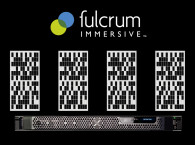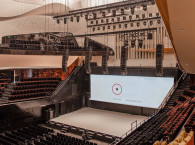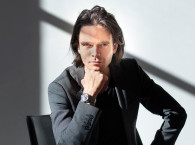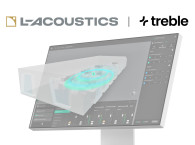
This partnership - as Meyer Sound calls it in the announcement, more than an "acquisition" - is an important step for the Oakland, CA-based company to reinforce its position in theater sound - a market that is also an essential part of Meyer Sound's growth history. From collaborating with legendary sound designer Abe Jacob in 1980 to bring the iconic UPA loudspeaker to Broadway to developing the new NADIA network-based digital audio platform, the company has continually created solutions that improve quality sound reinforcement.
Jonathan Deans is one of the world's preeminent sound designers, renowned for his pioneering work in immersive sound and his commitment to advancing the artistry of the craft. His work spans from Covent Garden, the Royal Opera House, and Broadway, to The Beatles "LOVE" and Michael Jackson's "ONE" productions in Las Vegas. Deans has been nominated for Tony and Drama Desk Awards and he is has been presented with a USITT award for his distinguished career in music.
Deans has contributed to hundreds of productions crafting bold soundscapes for 15 Cirque du Soleil productions. His relationship with Meyer Sound goes back to 1978 when he met founders John and Helen Meyer while working on a production of Evita using a Meyer-designed JM-3 loudspeaker. Meyer Sound acquired Deans’ previous company Level Control Systems in 2005, leading to an expansion of the company’s digital solutions.
"Jonathan is a recognized leader in the world of theater sound," says John McMahon, Senior Vice President of Meyer Sound. "We’re excited to join forces with him and his team as we continue to build upon our successes and expand our investments in the sector. My relationship with Jonathan goes back decades — to my LCS days — and I’m delighted to welcome a longtime friend into the fold," says McMahon.
"Meyer Sound has been there throughout my career, always providing support and always with an aligned focus on the audience experience, first and foremost," says Deans, who now assumes the role of Meyer Sound’s Senior Specialist, Theatrical Production Systems. "I founded Audio Rhapsody to build tools that remove the silos and barriers to creativity that are inherent in theatrical sound design systems and processes, and I’m so thrilled to complete that journey with a team of people who share the same passion."

A talented team of Audio Rhapsody partners also joins Meyer Sound. GRAMMY and Thea Award winner Jason Rauhoff, a former Meyer Sound employee, joins as Product Manager, Theatrical Production Systems. Rob Mele, also previously with Meyer Sound, assumes the role of Application Architect, Theatrical Production Systems, contributing to the software development team. Michael Kroll joins as Visual Designer, Theatrical Production Systems. Audio Rhapsody's Mike Tracey will remain an independent advisor.
The team is now commissioned to focus on developing the next generation of audio show control software for Meyer Sound's latest NADIA platform and immersive sound production. "Helping people stay connected with platforms that are usable not by the few, but by the many, is really important to me," says Deans. "This isn’t just about the generation of "now," it's the generation that's coming; the sound people who will be doing things that we haven't even thought about. Being able to aid them in their creative paths is a rewarding part of this journey, and integrating Audio Rhapsody's software approach with the excellence of Meyer Sound technologies is a realization of that vision," says Deans.

The latest Meyer Sound NADIA integrated, network-based digital audio processing and distribution platform is the solution that will power future installations of Constellation by Meyer Sound and provides processing power, inputs and matrixing to the Meyer Sound Spacemap Go spatial sound solution.
The NADIA platform combined the latest advancements in DSP technology with an AVB-Meyer Sound networking implementation that is customized for 96kHz/64-bit floating point signal processing and distribution, and optimized for active acoustics and immersive audio installations. The NADIA platform supports up to 96 inputs for Constellation acoustic processing as well as 128 independent program audio inputs and comprises three hardware modules. All NADIA-based systems require at least one NADIA-CP core processor that supports 128 outputs. Additional NADIA-CP modules can be added to increase the number of outputs in the extended system by 128 for each module.
In addition to meeting the unique requirements of active acoustics, the processing power of NADIA allows for a separate partition dedicated to integrating sound reinforcement systems alongside Constellation. A large number of inputs are reserved exclusively for Constellation, with additional inputs available for multi-channel spatial audio processing backed up by a new signal path featuring two matrix sections. Along with an input matrix — addressed by Spacemap Go for easy, intuitive, and creative spatial audio — users gain new levels of granularity and control with a separate output matrix.
For flexibility and seamless system integration, NADIA also can connect to Galileo GALAXY 816 and 408 processors as well as mixing consoles equipped with direct AVB-Milan outputs, multi-channel computer playback from AVB-compatible Macs or Windows PCs, and Avnu-certified format converters, switchers or routers, since the system is completely dedicated.
NADIA systems can be controlled by OSC commands to enable integration with third-party protocols when incorporating NADIA-based systems into wider AV and building control systems.
www.meyersound.com







